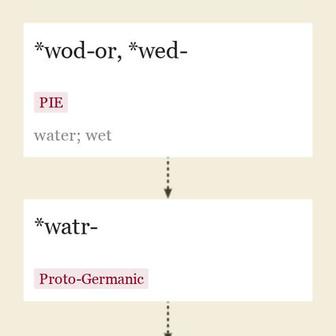dish-water (n.)
也称 dishwater,指“洗碗时用的水”,15世纪晚期源自 dish(n.)和 water(n.1)。1719年开始用于比喻意义,指淡汤、咖啡等。中古英语时期早期称为 dischwaschyngs(约1300年)。
dish-water 的相关词汇
古英语 disc “盘子,碗,大浅盘”,源自拉丁语 discus “盘子,大浅盘,铁饼”,在中世纪拉丁语中意为“桌子,讲台,书桌,教堂里的高台”,源自希腊语 diskos “铁饼,大浅盘”(参见 disk(n.))。
这是一个常见的西日耳曼语借词; 古高地德语将这个词作为 tisc “盘子”,但现代德语 Tisch 的意思是“桌子”,与其他一些后期罗曼语形式的 discus(如意大利语 desco,法语 dais)相同; 比较 desk(n.), dais。
“特定种类的食物”是15世纪中期首次记录下来的。1918年,“适合自己口味的东西”的意思出现了; “有吸引力的女人”的意思则出现在20世纪20年代。1948年,“凹面反射器或天线”的意思得到证实。
Originally applied to very shallow or flat vessels, as plates and platters, the term now usually includes any large open vessel, more or less deep, and with or without a cover, used to contain food or table-drink such as tea, coffee, or chocolate. The use of the term to include drinking-vessels, as bowls and cups, is less common, and seems to be obsolescent, except as such vessels are included in the collective plural dishes. [Century Dictionary, 1897]
最初只适用于非常浅或平的容器,如盘子和大浅盘,现在通常包括任何大型开放式容器,或多或少深,有盖子或没有盖子,用于盛放食物或餐桌饮料,如茶,咖啡或巧克力。将该术语用于包括碗和杯子在内的饮用容器的意思不太常见,似乎已经过时,除非这些容器包括在集体复数 dishes 中。[世纪词典,1897]

古英语 wæter,源自原始日耳曼语 *watr-(也源自古撒克逊语 watar,古弗里斯兰语 wetir,荷兰语 water,古高地德语 wazzar,德语 Wasser,古诺尔斯语 vatn,哥特语 wato "水"),源自 PIE *wod-or,是词根 *wed-(1)"水; 湿润"的带后缀形式。
在比喻意义上使用 keep (one's) head above water 的记录始于1742年。Water cooler 的记录始于1846年; water polo 的记录始于1884年; water torture 的记录始于1928年。语言学家认为 PIE 有两个表示水的词根: *ap- 和 *wed-。第一个(在梵语 apah 中以及 Punjab 和 julep 中保留下来)是"有生命的",指的是水作为一种有生命力的力量; 后者指的是水作为一种无生命的物质。fire(名词)可能也是如此。